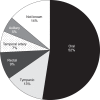Emergency Preparedness of Secondary School Athletic Programs in Arizona
- PMID: 30517023
- PMCID: PMC6464296
- DOI: 10.4085/1062-6050-35-18
Emergency Preparedness of Secondary School Athletic Programs in Arizona
Abstract
Context: Schools that sponsor athletic programs have an obligation to provide a safe environment with appropriate policies for addressing emergencies.
Objective: To describe the emergency preparedness of secondary schools in Arizona specific to emergency action plans (EAPs), cardiac arrest, concussion, and heat illness.
Design: Cross-sectional study.
Setting: Online survey.
Patients or other participants: Athletic directors from 143 Arizona secondary schools (response rate = 54%).
Intervention(s): A 6-section survey that included questions related to athletic trainer (AT) access, EAPs, automated external defibrillators (AEDs), concussion, heat illness, and other policies.
Main outcome measure(s): Descriptive statistics were reported. Comparisons of responses between schools with and without AT access were conducted with Mann-Whitney U tests.
Results: Most respondents (81%, n = 116) indicated their school had access to an AT, and 95% (n = 125) of respondents reported their school had a written EAP. The AEDs were available at most (93%, n = 121) schools. All respondents were familiar with the interscholastic concussion policy, and 98% (n = 123) indicated they had a school-specific policy. Almost all respondents (99%, n = 121) reported being familiar with the state heat-illness policy. Environmental measures were taken before practices at 48% (n = 60) of schools. Schools with access to an AT were more likely to have an EAP, venue-specific EAPs, physician approval of EAPs, AEDs, heat-illness policies, and cold-water immersion tubs and to take environmental measures.
Conclusions: Whereas the majority of schools reported AT access, not all schools had adequate EAPs in place. Schools would benefit from educational opportunities regarding best practices and policy development to improve emergency preparedness.
Keywords: athletic trainer; automated external defibrillator; concussions; emergency action plans; heat illness.
Figures





References
-
- Physical activity fundamental to preventing disease. US Department of Health and Human Services Web site. 2018 https://aspe.hhs.gov/basic-report/physical-activity-fundamental-preventi... Accessed July 31.
-
- Sallis JF, Prochaska JJ, Taylor WC. A review of correlates of physical activity of children and adolescents. Med Sci Sports Exerc. 2000;32(5):963–975. - PubMed
-
- 2014–15 High School Athletics Participation Survey. National Federation of State High School Associations Web site. 2018 http://www.nfhs.org/ParticipationStatistics/PDF/2014-15_Participation_Su... Accessed July 31.
MeSH terms
LinkOut - more resources
Full Text Sources
Medical

